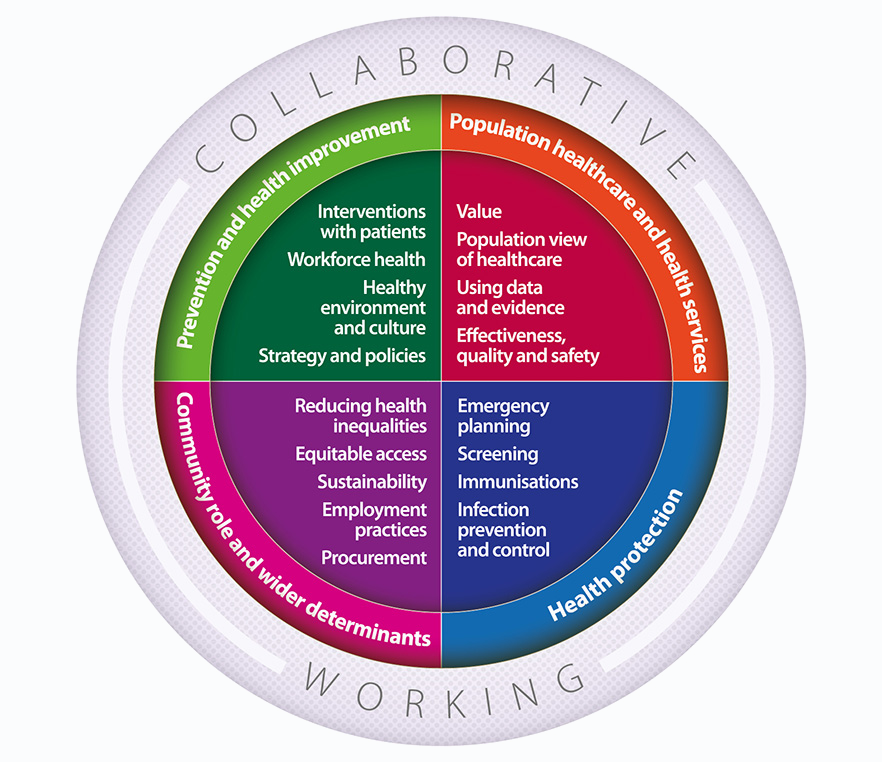This framework sets out principles for a population health approach that can be taken by NHS provider organisations, working as part of an integrated health and care system. It has been developed by the Provider Public Health Network, a group of public health professionals who work in or closely with NHS provider organisations.
Since the 2012 Health and Social Care Act there may have been a reduction in the involvement of many NHS organisations in population health activity, as noted in the Health Select Committee review in 2016. In the context of the renewed system wide focus on prevention in the NHS long term plan, this framework is intended to help NHS trusts review, describe, prioritise and further develop their contributions to population health, and contribute to the increasingly integrated approaches to the planning and delivery of care. It also includes case studies which demonstrate how some of these approaches have worked in practice.
Many of these activities are already taking place in NHS trusts to some extent. This framework can help trusts consider their approach to population health systematically, but it should be noted that it is not intended as a performance management framework. It covers five areas of healthcare providers' work.
The Provider Public Health Network is an independent forum, established in 2014, which is supported by the national Healthcare Public Health team within Public Health England.
Further details of members’ work can be found here.
The online forum for the network can be accessed here.
Population health framework for healthcare providers
1 Collaborative working
Building on a legacy of local partnerships and collaboration, the NHS long term plan sets out the aim for all sustainability and transformation partnerships (STPs) to become integrated care systems (ICSs) by 2021, with all organisations holding shared responsibility for contributing towards improving population health. Provider trusts should work in partnership with commissioners, other health and social care providers, the voluntary and independent sectors and community groups, and involve their organisation’s own staff, patients and their families.
2 Prevention and health improvement
All NHS organisations need to show how they address the prevention challenge identified in the NHS long term plan and the previous Five year forward view. Local authorities and Public Health England have specific responsibilities for preventative work, and primary care has traditionally provided the majority of this work with patients within the healthcare sector. However, with increasing levels of population multi-morbidity – predicted to affect two-thirds of adults aged over 65 by 2035, with a doubling of those living with four or more conditions from 2015 numbers – the case for an increased focus on prevention is now well recognised.
There are unique opportunities for prevention and health improvement within NHS provider organisations, which offer additional benefits to those happening elsewhere. With 23.4 million attendances at accident and emergency departments and 89.4 million at outpatient appointments per year, healthcare providers can support preventative work as part of the care and treatment for the patients they look after. Information and advice on prevention and health improvement can be embedded within the patient pathways through initiatives such as making every contact count (MECC). In addition, some patients, often the more vulnerable, for example rough sleepers, may only access care in a provider setting, which makes it even more important that they can be offered opportunities to improve their health alongside receiving care for health problems.
Promoting and improving the physical and mental health and wellbeing of their staff is also critical particularly with the challenges around staff recruitment and retention faced by many NHS provider organisations. Trusts should promote a safe and healthy workplace and environment for service delivery, developing an organisational culture and policies that encompass health improvement and prevention as core business.
3 Population healthcare and health services
With the nationwide move from STPs to ICSs by 2021, NHS providers will be increasingly accountable for contributing to jointly agreed population health outcomes to meet the needs of their local population. All providers within an ICS will be required to contribute to ICS goals and performance, and to take responsibility, with system partners, for wider objectives in relation to use of NHS resources and population health.
As shared population healthcare leaders, NHS provider organisations can play a vital role in developing and delivering high value care through helping design care pathways, prioritising care and evaluating outcomes, working with others across the health and care system. High value care is about ensuring a positive balance of costs versus benefits and encompasses clinical and cost-effectiveness as well as quality, appropriateness and minimising waste.
The population health skills of needs assessment, evidence-based service design and review, health economics, predictive prevention and public involvement are key to its delivery and are core pillars of the long term plan’s ambition for ICSs’ contribution to population health, which also includes the development and effective use of population health management approaches to help improve population outcomes. The data collected by NHS provider trusts on health needs and outcomes can also provide valuable insights into the health of the local population.
4 Health protection
NHS providers protect the health of the population through their contribution to population health programmes such as screening and immunisation, as well as through infection and environmental prevention and control, and business continuity and major incident planning. While already part of the routine work of most providers, all these require a system-wide, population level approach.
5 Community role and wider determinants
As 'anchor institutions', healthcare providers have many opportunities to improve health and wellbeing in the wider community. Like all public sector bodies they have a responsibility to demonstrate social value and to increase environmental sustainability, and the long term plan identifies further scope for reductions to the environmental footprint of the NHS. As large local employers NHS providers can demonstrate good employment practices and offer opportunities to local people for employment, learning and work.
NHS staff may also be patients, and in particular a trust's staff within pay bands 1-4 may comprise up to 7-8% of the local resident population in the most deprived areas around the country. This provides a unique opportunity for workforce health and wellbeing activities to positively impact on the health of the local population. Healthcare providers can also support the local economy through their support for local providers of goods and services.
Provider organisations can also make a major contribution to tackling health inequalities, by ensuring equitable access to their services and working with partners to identify the impact of and tackle wider determinants of health such as education and housing.
Conclusions
Many trusts are already doing excellent work to improve population health, with the potential to share learning and transferability across the system. This work is often led or supported by public health consultants, specialists or trainees in post or working closely with the trust, and there are opportunities to strengthen this capacity in most health communities.
Strengthening these functions could deliver many benefits, to the provider organisations themselves, their partners in local health and care systems, and in improved health outcomes for patients, their workforce and the wider population.


